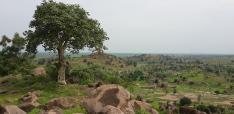War on Development in Syria: An Interview with Omar Dahi

This is part of PERI's economist interview series, hosted by C.J. Polychroniou.
C.J. Polychroniou: Why did you chose to study economics?
Omar Dahi: When I was young, I thought that economics was the key to changing the world. I grew up in Syria in a fairly left-wing family environment where Marxism and Arab Nationalism (in particular Nasserism) were big influences.
CJP: Do you identity yourself as member of a particular school of economic thought?
OD: Like many other critical economists and political economists, I’m interested in questions of unequal distribution of wealth and power and my thinking on those issues has been influenced by many different approaches. In graduate school I was lucky to be exposed to different schools of thought, including Feminist Economics and American Radical Political Economy. A lot of my own research on South-South relations emanates from Post-Keynesian, Neo-Marxian, and structuralist economic thought and is influenced by people with whom I study under in graduate school, such as Amitava Dutt and Jaime Ros. My recent research on peace and conflict and their relationship to economic well-being on the other hand has been significantly shaped by the work of James Boyce, a co-founder of PERI.
CJP: Your research revolves around issues in development economics and international studies, with emphasis in the Middle East. What exactly is development economics and how does it differ from other aspects of economics?
OD: Development economics deals with the themes that motivated me to study economics in the first place, which are why some countries are poor and others rich, and how can global inequalities between and within countries be reduced. The question of how- and whether -it differs from other aspects of economics is theoretically and ideologically contested and these contestations themselves have evolved as the discipline itself evolved since the mid 20th century. But at a basic level, many development economists believed that (a) the structural conditions of underdevelopment in developing countries (for example as a legacy of colonialism) coupled with (b) their subordinate position in the global hierarchy of power means that traditional approaches and prescriptions to economic growth have less relevance and that different approaches are needed. In early development economics there was a focus on state-led capital accumulation and improving agricultural productivity. Over the years, early development economics was critiqued from both the Left (dependency theory) and the Right (neoclassical economics and later neoliberal ideology). There was also a meta-critique of the discipline from outside as it was hopelessly infected with modernization theory. In the 1980s and 1990s there was a sort of neoliberal assault on development economics as an irrelevant field of study given that many development economists still talked about power, inequality, and imperialism – i.e., using a language that neoliberals wanted to erase from the discipline. Today there is a revival in development economics particularly with a focus on micro-approaches to development, which is thought to have been absent from early development economists, who were allegedly more concerned with macro-transformations.
CJP: You have written extensively about the crisis in Syria. Can you elaborate on what you mean when you say that the armed conflict in Syria is also a “war on development?”
OD: The phrase is not mine. I was quoting (approvingly) the title of a policy report by an independent Syrian research institute The Syrian Center for Policy Research, an organization I always had respect for and have since collaborated with on several occasions. At that time, they wanted to reframe the way the Syrian conflict was being discussed. The focus in the international media on the major actors or the rise of groups like ISIS, or almost a horse race coverage on “which side is winning” has overshadowed the fact that the armed conflict has destroyed the fabric of Syrian society. Syria had significant economic issues prior to 2011, but was solidly in the lower middle-income category. In 2007/8 it ranked 108th in HDI index, just behind Indonesia but ahead of other non-oil rich regional countries like Egypt (112th) and Morocco (126th). However, even that rank is weighed down by its relatively low GDP per capita. Life expectancy at birth was estimated as 73.6 years in 2005, which would have placed it among the medium- to-high human development countries. I think the number is a slight over-estimate, but it points to the a relatively advanced health care industry as a whole. Syria produced (relying on significant exchange with other Southern countries like India) 90% of its medicinal needs, while exporting medicine to over 50 countries. During my field research in Lebanon in 2013 I interviewed a doctor from Doctors Without Borders (MSF) working with Syrian refugees in Lebanon who told me they were very surprised that many of the refugees they treated, mostly villagers who were not very well educated, were very literate around mental health issues, very familiar with issues of depression, and would receive the latest medication, produced generically, from their Syrian doctors. Beyond health, Syria has historically been a peasant/agricultural economy and the Ba’ath government placed a premium on economic sovereignty, in particular food self-sufficiency. Syria housed a major center for agricultural research in dry areas (ICARDA) with a unique seed bank that was temporarily transported to the Norwegian Svalbard Global Seed Vault for safekeeping. In terms of indebtedness, Syrian debt to GDP ratio entering 2011 was around 25%, very low for a developing country. The war has shattered these accomplishments. Of course, loss of life is the biggest tragedy with an estimated half a million dead. But if we look at other metrics, in their latest report the SCPR projected life expectancy in 2019 in Syria at 62.9 years. The health care infrastructure has suffered immense destruction, and there has been a mass exodus of Syrian doctors, an estimated 13,000 from 35,000 before the war. In 2015, MSF said that chronic diseases had started killing as many people as did bombs and bullets. Food insecurity has increased significantly, and the poverty rate reached 89% by end of 2016. Abject poverty was less than 1% in 2010, but reached 45% in 2016. These are just small examples of the extent of the destruction. This did not happen by accident, but because of the pursuit of the armed conflict, because of the militarization of the conflict transforming it into a regional and international war. This war has destroyed the foundations of the Syrian economy and produced a devastated, highly dependent country that ranked around 155 in HDI, placing it squarely among the low human development countries in the world.
CJP: The popular uprisings that swept much of the Arab world in early 2011 have been widely interpreted as opposition to political authoritarianism, but acknowledgement has also been made of the fact that they were equally driven by salient economic factors such as dissatisfaction with the distribution of wealth and opportunity. Indeed, as you have argued, “by the late 2000s, the Arab States had become virtual oligarchies with an isolated and ruling elite […] and had succeeded in alienating whatever social base they had left”. In that context, you suggest that a better explanation for the uprisings can be found in “the political economy of regime consolidation.” Can you please describe briefly what you mean by this, especially given that the macroeconomic indicators prior to the uprisings were generally positive?
OD: There are two interrelated issues here. The first has to do with an accurate assessment of the economic record of those countries prior to 2011, while the second has to do with the actual role that economic issues played in the uprisings. Prior to the uprisings, some international financial institutions (IFIs) were celebrating countries like Tunisia and Egypt, where the uprisings first broke out, as economic success stories, ignoring significant poverty levels in place, but also public resentment against brutality, corruption, and the cohabitation of wealth and power in those regimes. However, the truth is that there were many things related to economic performance of the region as a whole that were not very well understood, not just by IFIs. One thing we’ve come to know a lot more about is inequality. Traditionally, and largely based on outdated notions of regional economic performance or economic statistics based on incomplete and imperfect data, many scholars used to point out that the Middle East North Africa (MENA) region had relatively lower levels of inequality than other regions in the global South. However, recent more comprehensive analysis by Thomas Picketty and his colleagues have found that the MENA region appears to be the most unequal in the world, higher than Brazil and South Africa, two countries widely known for extreme inequalities.
CJP: You have also written extensively about the refugee crisis in places like Syria, Jordan, and Lebanon. For Jordan and Lebanon, you argue that major development initiatives by the state are needed for those countries in order to meet the challenges they are facing on account of the Syrian refugee crisis. How would large-scale development be financed given that both countries in question live on heavy debt?
OD: The total amount of received humanitarian aid for Syria and the immediate neighboring countries in the past decade is estimated by the SCPR to be at USD 79.9 billion or 1.4 times that of 2010 Syrian GDP. That is a staggeringly high number. Since I was referring earlier to the armed conflict, I should point out that conservative estimates of weapons sales by the Syrian analyst Diana Bashur put the total amount for the 2011-2014 alone at USD 40 billion – and this figure looked at weapons sales by taking into account only North American and European countries, i.e., it did not include Russia. Thus, there was no shortage of funds being allocated to the region. The only questions were how the money was being spent and what were the priorities.
CJP: The rise of the global South has rapidly reshaped the world of the 21st century. How significant are South-South economic relations (trade and finance) in what you call “the emerging South”, but also in the rest of South?
OD: I think it’s fair to say that the last thirty to forty years have seen South-South economic relations become a major factor in ways they never were throughout the past century both in terms of things like merchandise trade and financial flows, as well as infrastructural investments. Since the early 1990s, South-South trade has grown substantially, reaching as high as 28% of world merchandise trade by 2013. North-South and South-North trade, however, remained relatively stable, with a slight increase for the latter. The importance of South-South exports in total Southern exports has also increased substantially, reaching from around 20% in the 1950s to 60% in 2013. However, this growth has not occurred within the entire global South, but in a subset of countries, which nevertheless include India and China and thus a significant number of the global South population. Still, the bulk of this is driven by a subset of about the 30 largest global South economies that can be labelled as the “emerging South.” Around 70% of South-South trade occurs between those “emerging South” countries. Likewise, more than 85% of South-North trade originates from Emerging countries in the South. In terms of financial flows, this has been more recent and is more difficult to measure than trade flows. However South-South financial flows have also increased significantly. Mainland China ranked number three globally in both foreign direct investment inflows and outflows in 2015. Within aggregate FDI flows to the South, South–South flows increased significantly, reaching around 63%-65% of all outflows from developing countries in 2010. In both Africa and Asia, half or more of inflows and outflows of foreign direct investment were in South-South direction.
CJP: Are there detectable differences in the recent wave of South-South relations and that of the so-called Third World era?
OD: That’s an important topic and one of the topics we discuss in our book South-South Trade and Finance in the 21st Century: Rise of the South or a Second Great Divergence with my co-author Firat Demir. But in brief, the “Third Worldist” era was a time period from the 1950s-1980s when developing countries formed significant anti-colonial and anti-imperialist political and economic alliances with each other, most prominently as part of the United Nations-created group of G-77. Outside the United Nations, the most prominent organization was the Non-Aligned Movement. The movement was driven by nationalist or left-wing leaders like Nasser, Nkrumah, Tito, Nehru, Castro. It was a different era energized by anti-colonial movements in Africa and Asia, and radical or nationalist movements in Latin America. The 1982 debt crisis and its aftermath, plus the shifting tides of neoliberalism, which made their way to developing countries themselves put an end to this development. The one place where such South-South blocs resurfaced was in the World Trade Organization, starting after the Seattle summit. Without romanticizing that era, these relations were much more solidarity driven, and smaller and poorer countries such as Cuba played a significant role due to the symbolic and moral power of their revolutionary experience and of course the charisma of Fidel Castro himself. Today we see South state-owned enterprises and large conglomerates driving economic, infrastructural, and security relationships. There is also a significant amount of South-South trade going on that is part of global North-South supply chains, and so the distinction is a lot more blurry. While in the past South-South trade was seen by development or heterodox economists as a positive development, today the process is regarded as being a lot more contentious. For example, there is an enormous academic literature about China’s presence in Africa though most people forget the famous Tanzania-Zambia railway built by China in 1970-1975, finished two years ahead of schedule. It cost $600 million, more than the Aswan Dam in Egypt and 25,000 of the 75,000 workers who worked on it were Chinese.
CJP: I see that you are co-founder and co-coordinator of the Beirut School of Critical Security Studies. Can you tell us about this initiative?
OD: This is the name of a working group that was launched in Beirut in 2017 under the auspices of the Arab Council for the Social Sciences, a regional independent grant-funding and research organization. The goal was to promote critical thinking about the practices of security and militarism by states within and outside the region, and to bring together a network of scholars committed to advancing non-Western perspectives on security studies. We tried to expand on our rationale for starting this initiative in a collectively written piece published in Critical Studies on Security. The Middle East region has been a source of external security and military intervention for decades with disastrous results for the people of the region. The sources of interventions are many, not just military and security but also economic, humanitarian, etc. However, it’s not just the traditional external factors at play. These processes and developments are also the work of regional state and non-state actors. The Beirut School seeks to amplify thinking about these issues by activists, scholars, and others in the region on their own terms. A big part of the initiative is engaging with and supporting young scholars in the region. For example, one of our main activities is an intensive week-long summer institute that brings Ph.D. students and junior scholars for training, mentoring and professional development.
CJP: What are your new areas of research?
OD: Right now, I am launching a new initiative along with several colleagues in the United States and abroad that we are calling Security in Context. As with the Beirut School, the initiative builds on the work of many scholars and activists who are dissatisfied with dominant notions and practices of security. The last decade we’ve seen significant attention being paid to two big questions: climate change and the crisis of extinction and the ever expanding global economic inequalities. To those two issues I think we should add a third, which is endless militarism and investments in “security,” a development which in fact produces increasing insecurity for large populations around the world. This initiative seeks to connect these three issues more directly and hopes to bridge public engagement with scholarly research, particularly highlighting perspectives from and about the Global South. Of course, there are lots of different dynamics and processes unfolding globally, where the US government remains a major but not the only actor, and in some cases a marginal actor. There are also multiple levels or scales of the processes of militarism, securitization, criminalization and control. That’s why a key aspect of this is engaging with Global South research centers and organizations to promote a North-South and South-South dialogue on these issues. The initiative is currently based at UMass Amherst with key partnerships at the University of California--Santa Barbara and the University of Oklahoma--Norman, but also involving other partnerships in the US and in Morocco, Turkey, and Lebanon. In the coming years we will also engage with centers in other regions. Along with these partnerships to produce joint and original research, the project will develop its own in-house research tracks as well as hopefully serve as a platform for discussion and analysis about these issues. Finally, we are in an academic setting, so we are also interested in producing material for instructors interested in teaching these topics, as well as provide training and mentorship opportunities for junior scholars interested in working in these themes and connecting with like-minded scholars elsewhere.
Omar S. Dahi is an associate professor of economics at Hampshire College and co-director of the Peacebuilding and Statebuilding program and research associate at PERI, University of Massachusetts Amherst. His research interests are in the political economy of development in the Middle East, South-South relations, comparative regionalism, peace and conflict studies, and critical security studies. He has published in academic outlets such as the Journal of Development Economics, Applied Economics, Southern Economic Journal, Political Geography, Middle East Report, Forced Migration Review, and Critical Studies on Security. His last book South-South Trade and Finance in the 21st Century: Rise of the South or a Second Great Divergence (co-authored with Firat Demir) explores the ambiguous developmental impact of the new economic linkages among countries of the global South. He is the project director of the “Security and Geopolitics in a Global Middle East” project hosted at PERI and funded by the Carnegie Corporation of New York.
This interview was reposted with permission from PERI.
Photo by samer daboul from Pexels


